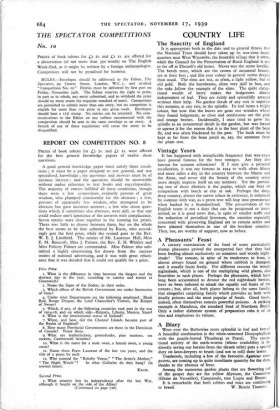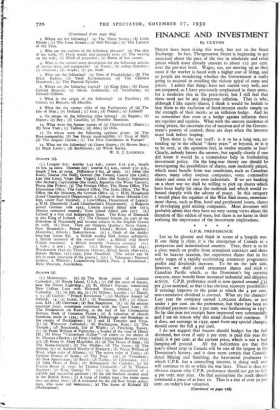THE SPECTATOR No. io
PRIZES of book tokens for £2 2S. and LI is. are offered for a dissertation (of not more than 35o words) on The English Week-End, as it might be written by a foreign anthropologist. Competitors will not be penalised for humour.
RULES.—Envelopes should be addressed to the Editor, The Spectator, 99 Gower Street, London, W.C. 1, and marked " Competition No. to." Entries must be delivered by first post on Friday, November 24th. The Editor reserves the right to print, in part or in whole, any entry submitted, and to withhold the prize should-no entry attain the requisite standard of merit. Competitors are permitted to submit more than one entry, but no competitor is eligible for more than one prize in any given week. Envelopes should bear a stamp. No entries can be returned. No com- munications to the Editor on any subject unconnected with the competition should be sent in the same envelope as an entry. A breach of any of these regulations will cause the entry to be disqualified.
REPORT ON COMPETITION NO. 8
PRIZES of book tokens for £2 2s. and Ls Is. were offered for the best general knowledge papers of twelve short questions.
A good general knowledge paper must satisfy three condi-
tions ; it must be a paper designed to test general, and not specialised, knowledge ; the questions and answers must be of intrinsic interest ; and the questions should be answerable without undue reference to text books and encyclopaedias.
The majority of entries fulfilled all these conditions, though there were a few competitors, evidently persons of great wisdom, who plumped consistently for the abstruse ; a few, persons of apparently less wisdom, who attempted to be abstruse but gave incorrect answers ; a few who chose ques- tions which, if sometimes also abstruse, were dull, so that one could endure one's ignorance of the answers with complacency. Seven entries were close together in the running for prizes. There was little to choose between them, but on the whole the best seems to be that submitted by Kacie, who accord- ingly gets the first prize, while the second goes to the Rev. W. E. J. Lindfield. The entries of Mr. Laurence Hall, Miss E. M. Bancroft, Miss J. Painter, the Rev. E. H. Whitley and Miss Felicity Palmer are commended. Miss Palmer also sub- mitted a highly entertaining list drawn from the success stories of national advertising, and it was with great reluct- ance that it was decided that it could not qualify for a prize.
First Prize.
s. What is the difference in time between the longest and the shortest day in the year, according to sunrise and sunset at Greenwich?
2. Name the Signs of the Zodiac, in their order.
3. Which offices of the British Government are under Secretaries of State?
4. Under what Departments are the following employed: Black Rod, Rouge Dragon, the Lord Chancellor's Visitors, the Keeper of Swans?
S. Which, if any, of the following countries took part in the war of 1914-18, and on which side—Bulgaria, Liberia, Mexico, Siam?
6. What is the international status of Iceland?
7. When, and how, did the Channel Islands become part of the Realm of England?
8. How many Provincial Governments are there in the Dominion of Canada? Name them.
9. What are leatherjackets, greenshanks, pine martens, sea rockets, Camberwell beauties?
so. What is the name for a male swan, a female swan, a young swan?
H. Name three Poets Laureate of the last TOO years, and the title of a poem by each.
12. Who painted the " Rokeby Venus," "The Artist's Mother,"
"The Night Watch "? In what Galleries do they hang? (in normal times).
KACIE.
Second Prize.
z. What country lost its independence after the last War, although it fought on the side of the Allies?
(Continued on page 726)
(Continued from page 684)
2. Where are the following? (a) The Three Sisters ; (b) Little Rhody ; (c) The Looe Stream ; (d) Hell Passage ; (e) The Lantern of the Fens.
3. Who are the authors of the following phrases? (a) The skin of my teeth; (b) Fresh woods and pastures new; (c) The writing on the wall ; (d) Whiff of grapeshot ; (e) Home of lost causes.
4. What is the correct army description for the following articles of service dress and equipment? (a) Tunic ; (b) riding breeches ; (c) overcoat ; (d) stripes ; (e) gas mask.
5. What are the following? (a) View of Frankpledge ; (b) The Black Rubric; (c) Valor Ecclesiasticus; (d) The Chiltern Hundreds ; (e) The Pastoral Epistles.
6. Where are the following buried? (a) King John ; (b) Dante Gabriel Rossetti; (c) Oliver Goldsmith; (d) Swinburne; (e) Edward Gibbon.
7. What is the origin of the following? (a) Pytchley ; (b) Canter; (c) Boycott; (d) Maudlin.
8. What the the correct tides of the Parliaments of (a) The Isle of Man ; (b) Holland ; (c) Iran ; (d) Poland ; (e) Iceland?
9. To whom do the following titles belong? (a) Regent ; (b) Mpret ; (c) Bey ; (d) Caudillo; (e) Pontifex Maximus.
to. What were the former names of (a) Christchurch (Hants.); (b) New York ; (c) Tallinn ; (d) Abo ; (e) Oslo.
it. To whom were the following epithets given: (a) The Ever-memorable; (b) Sea Green incorruptible; (c) Vicar of Hell; (d) The Angelic Doctor ; (e) The First Gentleman in Europe?
12. What are the following? (a) Green fingers ; (b) Brown Bess ; (c) Black Letter ; (d) Redbreasts ; (e) White Surrey.
W. E. J. LINDFIELD.
Answers (1).
(t.) Longest day: sunrise 3.45 a.m., sunset 8.19 p.m., length 16 hrs. 34 mina. Shortest day: sunrise 8.5 a.m., sunset 3.51 p.m., length 7 hrs. 46 mins. Difference 8 hrs. 48 mins. (2.) Aries (the Ram); Taurus (the Bull) Gemini (the Twins); Cancer (the Crab); Leo (the Lion); Virgo (the Virgin); Libra (the Scales); Sagittarius (the Archer); Capricornus (the Goat); Aquarius (the Water Carrier); Pisces (the Fishes). (3) The Foreign Office, The Home Office, The Dominions Office, The Colonial Office, The India Office, The War Office, the Air Ministry, the Scottish Office. (4) 1. H.M. Household (Lord Chamberlain's Department). z. College of Arms (Heralds Col- lege, under Earl Marshal). 3. Law Offices, Department of Lunacy. 4. H.M. Household (Lord Chamberlain's Department). 5. Bulgaria joined German side 1915; Liberia joined Allied side 1917; Mexico remained neutral ; Siam joined Allied side 1917. (6.) Iceland is a free and Independent State. The King of Denmark is also King of Iceland. (7.) The Channel Islands are part of the Dukedom of Normandy and became subject to the English Crown in io66. (8.) Nine. They are Ontario; Quebec ; Nova Scotia ; New Brunswick ; Prince Edward Island ; British Columbia ; Manitoba ; Alberta ; Saskatchewan. (9.) I. Grub of the daddy- long-legs (crane fly). 2. British wading bird (tringa nebularia). 3. British mammal of the weasel tribe. 4. British wild flower (Cakile maritima). 5. British butterfly (Vanessa antiopa) (to.) t. Cob ; 2. Pen ; 3. cygnet. (II.) Robert Southey till 1843 Wordsworth 1843-50; Tennyson 1850-92; Alfred Austin 1896-1913; Robert Bridges 1913-1930; John Masefield. (The solver can be left to make selections of the poems.) (12.) t. Velasquez ; National Gallery. 2. Whistler ; Luxembourg Gallery, Paris. 3. Rembrandt ; Ryks Museum, Amsterdam.
Answers (2).
(I.) Montenegro. (a.) (a) The three spires of Lichfield Cathedral ; (b) Rhode Island, U.S.A. ; (c) Off the coast of Sussex, near the Owers Lightship ; (d) St. Helen's Passage, connecting New College Lane with Holywell Street, Oxford ; (e) Ely Cathedral. (3.) (a) Job, xix, 20 ; (b) Milton: Lycidas ; (c) Daniel, v. 5 ; (d) Carlyle: "French Revolution "; (e) Matthew Arnold (of Oxford). (4.) (a) Jacket, S.D. ; (b) Pantaloons, S.D. ; (c) Great- coat, S.D. ; (d) Chevrons ; (s) Box Respirator. (5.) (a) An ancient manorial court, sometimes combined with the Court Leet ; (b) The Declaration on Kneeling, at the end of the Communion Service, Book of Common Prayer ; (c) A valuation of church benefices, made in ip4; (d) Stoke, Desborough and Burnham in the county of Buckingham ; (e) I and H Timothy and Titus. (6.) (a) Worcester Cathedral ; (b) Birchington, Kent ; (c) The Temple ; (d) Bonchurch, Isle of Wight ; (e) Fletching, Sussex. (7.) (a) From William of Pightesley, a hunter of the time of Henry III ; (b) From " Canterbury Gallop "-of riders to the shrine of St. Thomas a'Becket ; (c) From Charles Cunningham Boycott (1832- 97); (d) From St. Mary Magdalen. (8.) (a) The House of Keys ; (b) The States-General ; (c) The Mejliss ; (d) The Seym ; (e) The Althing. (9.) (a) Admiral Horthy of Hungary ; (b) Prince William of Wied, when ruler of Albania ; (c) The native ruler of Tunis ; (d) General Franco of Spain ; (e) The Pope. (to.) (a) Twineham ; (b) New Amsterdam ; (c) Reval ; (d) Turku ; (e) Christiania. (IL) (a) John Hales of Eton ; (b) Robespierre (by Carlyle); (c) Sir Francis Bryan (d. 1550: by Thomas Cromwell) ; (d) St. Thomas Aquinas ; (e) King George IV. (12.) (a) the description of a capable and successful gardener ; (b) An old flintlock musket used in the British Army ; (c) A form of Gothic type ; the name came into use about 1600 ; (d) A nickname for the old Bow Street police- men, who wore red waistcoats ; (e) The horse of Richard III (Shakespeare).





































































 Previous page
Previous page